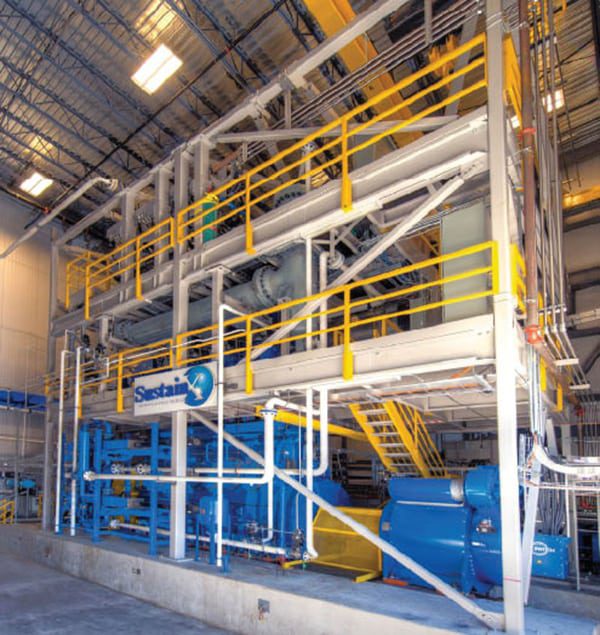First Megawatt-Scale Isothermal CAES Completion
SustainX in September completed construction of what it says is the world’s first megawatt-scale isothermal compressed air energy storage (ICAES) system. The system at the company’s headquarters in Seabrook, N.H. (Figure 3), essentially takes electricity from the grid and uses it to drive a motor that compresses air and stores it isothermally, or at near constant temperature.
The project marks an important development for compressed air energy storage (CAES). Since commissioning of the only two existing CAES plants in the world—the 290-MW Huntorf plant in north Germany in 1978 and the 110-MW Alabama Electric Corp. plant in McIntosh, Ala., in 1991—CAES developments have been rare. One reason for this is that setting up a CAES facility is pricey and requires finding a geologic formation that can support it. For example, both the German and Alabama plants store compressed air in mined salt caverns.
CAES plants work like big batteries. Electric motors drive compressors that compress air (at perhaps 1,100 psi) into an underground geologic formation during off-peak hours. When the electricity is needed most, the precompressed air (essentially replacing the compressor in a traditional combustion turbine) is used in modified combustion turbines to generate electricity. Natural gas or other fossil fuels are still required to run the turbines, but the process is more efficient because it uses up to 50% less natural gas than standard production, according to Sandia National Laboratories. However, the efficiency of the 320-MW plant in Huntorf is about 42% and that of the McIntosh plant is 54%—20 percentage points lower than conventional pumped storage plants.
What lowers the efficiency of those plants is that the air that heats up during compression must be cooled down to ambient temperature before it can be stored. Then, the cold air must be reheated for discharge of the storage facility because it cools tremendously when expanding in a turbine for power generation.
That is why CAES technology developers have been assessing how to best develop approaches to store that heat generated during compression, which can considerably improve the efficiency of the system if it is used during expansion. Germany’s RWE, for example, is developing an “adiabatic” process for its ADELE-Stassfurt project, which is in its initial one-year project phase. That project compresses air at times of high electricity availability and places resulting heat in an interim heat-storage facility while injecting the air into subterranean caverns. The heat-storage facilities are up to 40-meter-high containers with beds of stones or ceramic molded bricks through which the hot air flows. A demonstration plant expected to have a storage capacity of 360 MWh could probably go online in 2016 at the earliest, says RWE, which is backed by the German Aerospace Centre and the federal ministry for economics.
SustainX’s ICAES system takes another approach. The system essentially captures the heat produced during compression, traps it in water, and stores the warmed air-water mixture in pipes. When electricity is needed back on the grid, the process reverses and the air expands, driving a generator. According to the company, the isothermal gas compression is thermodynamically ideal—that is, it requires the least possible work—and by definition avoids temperature extremes. An isothermal expansion process is also ideal, recovering the most possible work from the compressed air.
However, while “perfectly isothermal” compression or expansion is not practical, the company says, a gas can be expanded or compressed near-isothermally if heat exchange occurs quickly enough relative to density change. That’s why the company uses an aqueous foam-based heat exchange in its ICAES system. The patented two-phase heat transfer process enables near-isothermal gas expansion and compression between 1 atmosphere and 200 atmospheres with only two stages and at scales and speeds appropriate for large-engine reciprocating machinery, it says. “Rapid heat exchange between liquid and air has allowed development of a megawatt-scale compressor/expander with [more than] 95% isothermal efficiency over a large operating range and at large-engine stroke speed, keeping the temperature change of the liquid-air mixture to under 50C across the full operating range of the system,” it claims.
SustainX’s isothermal process was developed by the Thayer School of Engineering at Dartmouth College in 2007 with funding from the National Science Foundation Small Business Innovation Research Program plus equity investments from Polaris Venture Partners, Rockport Capital, and General Electric, as part of its GE Ecomagination Challenge.
